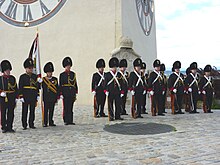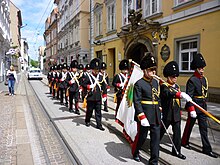Privileged uniformed Graz citizen corps
The privileged uniformed Graz citizen corps was founded in 1280 to protect the city of Graz and is therefore the oldest association in the Styrian capital. Today the association moves out to maintain tradition and camaraderie on various occasions, true to its motto "For loyalty, courage and citizenship". The corps bar is located by the garrison church in the basement (former canteen) of the Barmherzigen Brüder Graz .
history
Before World War II
When the cities developed in the Middle Ages as those places to which the city lord granted special rights and freedoms, vigilante groups (citizen corps, citizen guards) were formed, which were initially solely responsible for fortifying and defending the city. In addition, they had to ensure inner peace and order in the city. This high social goal of participating in the self-defense of the urban community was changed in the 18th century, when increasingly standing armies had taken on this task, so that the citizen guard in the event of the absence of the garrison for peace and order in the city by the Had to take care of the security service.
The Graz citizen corps emerged from the medieval vigilante group, which had the task of defending the city and the military campaigns of the sovereigns. If one considers the “Graz Citizens Corps” as the last surviving branch of the Graz Citizens' Guard, the historical tradition can be traced back to the 13th century. As a result, the rise of the well-fortified citizenry before King Rudolf I of Habsburg in 1280 can definitely be considered the year of foundation.
With the establishment of standing armies by Maria Theresa , the Graz Citizens Corps lost its importance, also because the autonomy of the city of Graz was weakened. However, it continued to move in a representative function for parades, weddings, hereditary tributes and processions. A picture in the GrazMuseum shows a solemn parade for Emperor Leopold II. Maria Theresa's tight military facilities initially meant the end of the historical significance of the vigilante group. The elementary baroque joy of festivities and lifts prompted the master brewer Richard Seebacher (1717–1805) to revive this historic institution in the form of a freely established bourgeois hunter corps.
In the Graz Citizens' Corps, the citizens prepared themselves in order to guarantee public safety, to prevent looting and to prevent clashes during the French occupation of Graz in 1797, 1805 and 1809. Towards the end of the 18th century, the desire for a permanent, well-organized citizen militia was expressed and insisted on strengthening and unifying the civil defense associations. This is how the three civil corps were united in Graz: the Jäger Corps, the Grenadier Corps and the Cavalry Corps.
During the time of the French Wars , when the Graz garrison had to move into the field, the civil corps had to take over the guard duty. This service under wartime conditions provided urgent proof of the indispensability of the corps and brought it a series of official acknowledgments as well as a flag ribbon donated by Maria Theresa of Naples-Sicily (the second wife of Emperor Franz II ) . At the height of the French invasion (1809), the Graz Citizens Corps comprised 1,300 members.
Much has changed for this Graz city guard over the years. The uniform changed shape and color. Instead of a lance and a halberd , bayonet and rifle were used and the tasks assigned to the corps were adapted to the needs of the times. The preservation of important landmarks of the state capital - clock tower and bell tower on the Schlossberg - is a merit of the Graz Citizens Corps: at the time of the French War of 1809, the Corps collected from all estates in order to be able to pay the amount demanded by the French so that these buildings can be used in the Destruction of the fortress were spared.
With the introduction of general conscription in 1866, the Graz Citizens Corps was also integrated into the defense system of the monarchy . The guarding of the powder and food magazines as well as the security service were in his hands. In addition, there were also always solemn occasions at which the citizen guard was present. It was part, especially of the festive cityscape, that the citizen corps took part in the parades in their old historical uniforms with high bearskin hats . On the occasion of the 600th anniversary of the House of Habsburg in 1883, which was also celebrated in Graz and to which Emperor Franz Joseph appeared on July 1st , the Graz Citizens Corps provided the music and the honorary company as a festive setting for this anniversary.
During the First World War it was the Graz Citizens Corps that sent a marching company to the borders of the Reich. It was ceremoniously adopted on Franzensplatz (today: Freiheitsplatz) with great sympathy from the population of Graz.
From 1914 to 1918 the civil corps in Graz had to provide a daily number of guards of initially 200 men, which was, however, heavily thinned by repeated mustering and voluntary engagement. Then the war was over - and once again the corps had to be on duty in troubled days - as a stabilizing element, maintaining peace and order. Only after the signing of the Peace Treaty of St. Germain did the corps disband in November 1919.
The disintegration of the old empire also put an end to the Graz citizen corps in 1918. After the war, the dissolved citizen corps was organized in 1923 on the basis of association law and even if it was no longer used to protect the city and its citizens as it was in the past, it was important to maintain a centuries-old tradition.
After the Second World War
After the end of the Second World War , the rebuilding of the Graz Citizens Corps began in 1953. Under difficult circumstances, the surviving old members managed to increase the number of members in the Graz Citizens' Corps again. Under the corps leaders Heindler, Drobir and Reihs the recognition of the Graz Citizens Corps could be achieved again. The main task now was to demonstrate the representation of the Graz Citizens Corps to the public in the context of deployments. The highlight was undoubtedly the flag consecration on Freiheitsplatz in 1966.
After this climax it went - also for socio-political reasons - so to speak in free fall into a veritable crisis and thus steeply downhill. Even an exhibition about the citizen corps in the Landeszeughaus in 1978 as a contribution to the 850th anniversary of the city of Graz could not change that.
The preparations for the 700th anniversary of the Corps took younger comrades into their own hands and this point in time can confidently be described as the "birth" of today's Graz Citizens Corps, because now a positive upward trend began: the number of members rose, the statutes were revised, A funeral order was drawn up, the promotion guidelines were issued and all active members received the "Handbuch des Grazer Bürgererkorps", in which the adjustment and the exercise were presented in detail (in addition to general information about the corps, such as a brief history, the statutes, etc.).
In 1984 a rifle campaign was carried out to purchase Mauser K 98 carbines in order to ensure the armament of the Graz citizen corps. Well-known representatives of public life participated as donors, above all the Styrian governor and the mayor of the provincial capital Graz.
As the number of members continued to grow, it became necessary to give up the old corps office and move into a larger one in the same building. For this a conversion was urgently necessary. This was carried out in two stages and independently under the supervision of the cashier Josef Mailänder. The new corps office enabled the comrades' meetings, which took place on the 1st Tuesday of the month and are still taking place, to be carried out without complaint. Above all, they served to pass on relevant information to the members in the form of slide presentations or film screenings. A historical preparation of the history of the Graz Citizens Corps was carried out by corps leader Dr. Hans Wallner, who, as a historian, has particularly taken up this topic.
In 1987, around 20 years after the flag consecration on Freiheitsplatz, the Graz Citizens Corps was able to consecrate its new corps flag as part of a standard ribbon handover to the Panzer Artillery Battalion 4 in the Hackher barracks in Gratkorn . It is a hand-painted silk flag (based on the pattern of the last hand-painted flag of the Austro-Hungarian Army from 1836), which was made by corps commander Emil Reiter himself and donated to the corps by him and his family. In 2002, the Mannlicher M 95 bolt-action socket was purchased as historical armament ; it replaced the Mauser K 98 carbine as a salute weapon. The privileged uniformed Graz Citizens Corps has also taken Europeanization and globalization into account and has become a member of the Association of Traditional Associations of Central Europe (VTM) . This association was headed by Colonel Carl H. van Veenendaal (Salzburg), an old friend of our traditional association. A rent increase for our Korpslokal in Dominikanergasse and unfulfilled financial promises of politics at major events forced the Citizen Corps to move to another Korpslokal at the end of 2008, namely the former canteen at the Barmherzigen Brothers in Marschallgasse.
equipment
Uniformity
The description of the adjustment and arming of the Graz Citizens Corps dated June 24, 1954, which was registered by the association authorities, provides for the old uniform for the grenadier division - and only this was rebuilt - according to the regulation from 1911, but not in steel green, but in black. The old bearskin hats (kuk pattern 1836) were replaced by a smaller model in 1954 due to the destruction of the remaining stocks during and after the end of the Second World War. The exit cap from 1849 is also in use.
Armament
The Graz Citizens Corps has both rifles of the model 1867 Werndl cal. 11 mm , which is intended for honorary posts, as well as Steyr Mannlicher M95 rifles which are used for other deployments and for shooting the General d´Charge. In addition, the crew wears the corresponding bayonets and the grenadier saber M 1765. Officers wear the infantry saber M 1861.
Individual evidence
- ↑ a b c 360 GRAZ The City of All Times - The Open City 1600 - 1809. ( Memento of the original from May 14, 2014 in the Internet Archive ) Info: The archive link has been inserted automatically and has not yet been checked. Please check the original and archive link according to the instructions and then remove this notice. P. 5.
- ↑ Festschrift 725 Years of Privileged, Uniformed Graz Citizens' Corps. Graz 2005, p. 30.
- ↑ Handbook of the priv. Unif. Graz Citizens Corps, pages 6–9
- ↑ Festschrift 725 Years of Privileged, Uniformed Graz Citizens' Corps. Graz 2005, p. 31
- ↑ Festschrift 725 Years of Privileged, Uniformed Graz Citizens' Corps. Graz 2005, p. 32
- ↑ Handbook of the priv. Unif. Graz Citizens' Corps, pages 9–13
- ↑ Handbook of the priv. Unif. Graz Citizens' Corps, pages 17-19
- ↑ Handbook of the priv. Unif. Graz Citizens' Corps, pages 20-22




